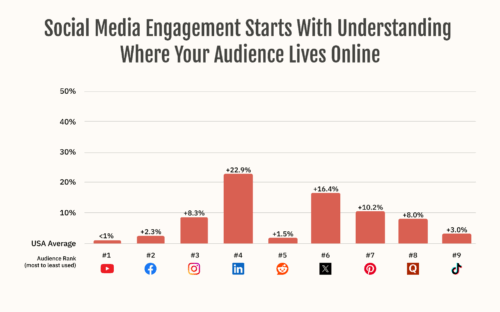Article's Content
If you work in B2B, LinkedIn is a gold mine.
There are more than 930 million users on LinkedIn in over 200 countries, with more people joining at a rate of three new members every second.
These users are professionals from every industry who are on the platform during working hours with their business caps on.
Even with a diverse, ever-growing user base, LinkedIn’s features and advertising tools make it easy to find your targets in the crowd and speak to them with your content in a way they would expect.
This guide covers everything LinkedIn has to offer so that you can get started on the platform with confidence or elevate your current efforts and generate real results.
Still unsure whether B2B marketing on LinkedIn is worth it? That’s where I’ll start:
Get a PDF version of this guide
In a rush? We’ll send you a downloadable PDF of this guide for you to check out later and share with your team.
By downloading this resource, you’ll also start receiving a few emails per week on B2B growth and content marketing.
What Are The Benefits Of B2B Marketing On LinkedIn?
Like any social media platform, LinkedIn gives you and your business the opportunity to build brand awareness, connect with your audience, form meaningful connections, and promote your products and services.
What makes LinkedIn different from Facebook, Twitter, and Instagram is the word “professional.”

Ok, so maybe not every LinkedIn user is as … intense as Miranda Priestly, but most are dedicated professionals in their respective industries.
Active users are talking about their work and engaging with content that’s relevant to their jobs. No memes or cat videos here! Well, maybe some, but even the humorous content has a different tone.
When you form connections on LinkedIn, you’re forming connections with professionals — more than that, you’re forming connections with decision-makers. In fact, 80% of LinkedIn members are in a decision-making role. By marketing here, you gain direct access to the people you need to reach at the companies you’re targeting.
The relationships you build as an individual on LinkedIn are strategic right from the moment you send or accept that request to connect. For a business, these connections are like partnerships.
LinkedIn marketing for B2B is smart marketing and, frankly, a no-brainer for reaching your audience faster and generating more quality leads.
Here’s how to do that:
How To Set Your Company Up For Success On LinkedIn
Whether your business is on LinkedIn already or you’re just getting started, it’s important that you’ve done all the basics right and in order to increase your chances of success. Here are the steps you’ll want to take:
1. Set Up Your Company Page
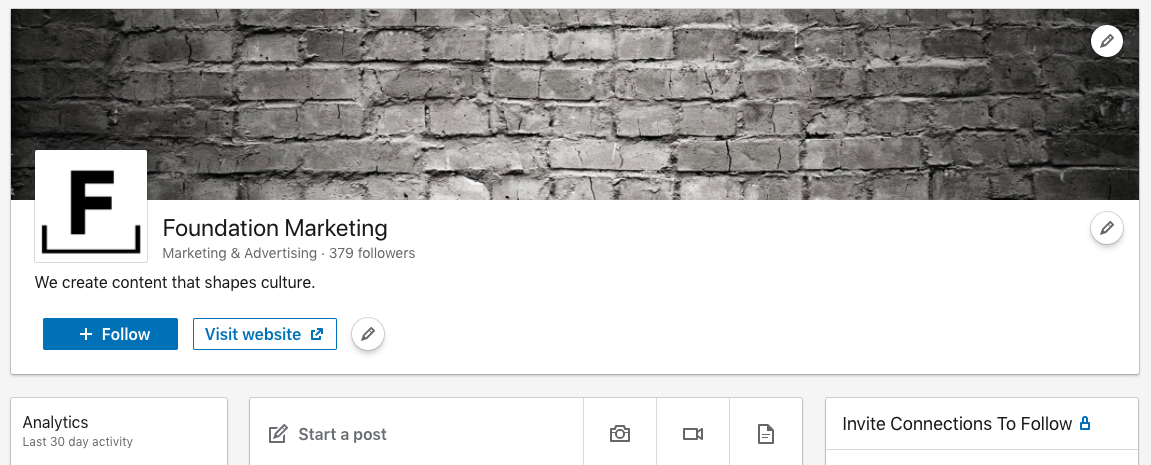
Depending on your industry, LinkedIn can be one of the best tools for startups or new business owners looking to generate buzz and market their business online. If your company doesn’t have a page, creating one is the obvious first step!
Fill out your profile completely, including the description, profile picture, and banner. Use your company’s logo and branded imagery that’s consistent with imagery on your website and other social platforms.
2. Define Your Audience & Goals
You should have a strategy for every channel you’re on; LinkedIn is no different.
First, what is your objective? Are you using the channel to increase brand awareness? To generate more leads? Maybe you’re using it as a PR tool.
Then, you’ll want to define your company’s audience and persona.
Understanding what you’re working toward and who you’re targeting will make it easier to determine everything from what content to share to which calls to action to use in your ads.
3. Optimize Your Page
Just as you optimize your website for search (I hope), you want to make sure your LinkedIn business page is search-friendly. That means using keywords that your target audience is actively searching for.
These keywords can be used in your profile description and to list your company’s specialties.

Another important aspect of optimization is page promotion. You can’t just expect people to stumble upon your profile — you have to put in a little bit of work! Link out to your page on your website, share it across other social media channels, send it to your newsletter subscribers, insert a CTA in a blog post, etc.
4. Add A Showcase Page
If you run a big organization with multiple brands, product lines, or business segments, showcase pages are for you.
These “affiliated” pages are extensions of your main business page, with nearly identical functionality. The benefit of having multiple pages is that each of your brands can maintain its unique voice and personality. (By the way, you’ll need to follow steps 1-3 above for these showcase pages too.)
Once you’ve got your house in order, it’s time to get active!
LinkedIn Marketing Strategies & Best Practices
A complete and optimized business profile is not enough to market effectively on LinkedIn. You also need a plan. Let’s dive into some proven strategies for maximizing your LinkedIn marketing efforts and leveraging the full power of this platform to drive results:
Post Regularly
Consistency. Consistency. Consistency.
As on any social networking site, staying active is the key to remaining relevant and top of mind. A prime example of this is eWebinar CEO Melissa Kwan who has leveraged her consistent posting schedule to amass over 30,000 LinkedIn followers and have multiple posts go viral.

If you can post a few times a week, post a few times a week; if you can post daily—even better! You can even schedule LinkedIn posts in advance to keep up with the posting frequency.
When you do post, you should always be thinking, How does what I’m about to post provide value?
- Is it teaching my followers something they don’t know?
- Is it providing an actionable tip?
- Is it entertaining in some way?
No matter which angle you take, your content should always be authentic. That’s how you build trust. And by posting about topics that are relevant to your audience, you can demonstrate your authority and provide thought leadership.
Struggling to consistently come up with new ideas? Curating industry content is one way to provide value to your audience while using content that’s already circulating the net.
LinkedIn has a handy tool for generating ideas, too — you can use the Content Suggestions tab on your company page to figure out what topics your followers are currently interested in.
Post Strategically
Research says the best time to post on LinkedIn is during typical working hours, with 10 a.m. to 12 p.m. Tuesday to Thursday yielding the most success.
Sprout Social prepared a great graphic that further narrows down the best time to post on LinkedIn:

This makes sense—remember, LinkedIn is a professional networking site. It’s typical to find users online while they’re at work or engaging in work-related activities. They are not likely to be scrolling their feed on the weekend. Meet them when and where they are.
Experiment With Media
When you start out on LinkedIn, you may not know exactly what types of posts are going to resonate the most with your audience, so it’s important to try out various styles and formats and see what gains traction over time. Experiment with:
- Digital flipbooks
- Short posts
- Long posts
- Images
- Emojis
- Listicles
Unsure where to start? These content formats tend to work well across industries:
Video Content
According to LinkedIn, video content shared on the platform gets 5x more engagement than non-video content, and live video gets 24x more engagement. That’s huge!
Video has been increasing in popularity across social media for a few years now; at this point, its value for marketing has been established. But you still have to do it right.
Keep your videos on the shorter end — research shows that B2B buyers are looking for videos under two minutes long when considering a purchase.
Native Articles
Not only can you share links to your blog content on LinkedIn, but members of your team can also use LinkedIn’s article function on their personal profiles to blog directly on the site.
To do this, click “Write an article” rather than “Start a post” on your personal feed, and you’ll be taken to a publishing tool that’s like a simplified version of Word.

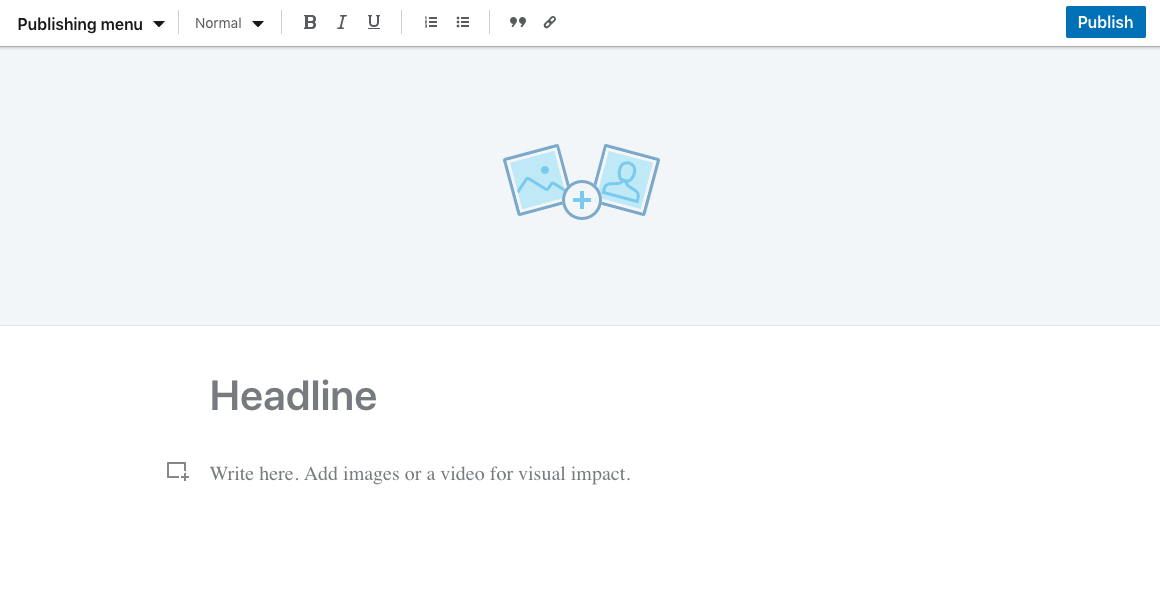
A reminder that this functionality is only for personal profiles, so you’ll have to decide who on your team will author each post. That said, you can still take advantage of this exposure from a company standpoint. Make sure that the author mentions your company in the update; this will accomplish a few things:
- Allow you to reshare the update on your company page
- Make it easy for anyone who comes across that update to click through to your business page
- Build your brand authority through your team
When you use a channel’s native functionality, your content is nearly guaranteed to have better reach. Of course a lot of other factors come into play, but no site wants you leaving their platform. So between an article that links out to another site and an article hosted on LinkedIn, the latter is going to get preferential treatment—meaning it’ll be in front of more users.
Build Relationships & Drive Engagement
Remember, marketing on LinkedIn is, first and foremost, about forming relationships.
You may think it’s hard to do that as a business, and you’re right — but it’s not impossible. I’ll say this: Building your brand on LinkedIn is closely tied to how you build your personal brand on the platform, and pivoting back and forth is the key to accomplishing both successfully. Integrating LinkedIn automation software into your strategy or connecting your CRM to LinkedIn can significantly streamline the process of building these relationships and driving engagement.
Any employee should recognize that when they engage online, they are representing their place of business — particularly on a platform where you’re directly listed as an employee. Sharing updates and opinions that build yourself up as a thought leader establishes you as an authority in your industry. This reflects positively on your company too.
Then some powerful synergy happens when the brand, in turn, starts highlighting its amazing team. Which leads me to …
Showcase Your Team
Showing the people behind your business is essential.
Who are your employees? What are they up to? Share their knowledge and show their faces on your LinkedIn using a high-quality headshot.
People trust people. People want to engage with people. People want to buy from people. So humanize your brand by showing off your team.
Take this a step further by resharing your employees’ posts on your company page when they mention your brand. This type of content resonates well with audiences across industries because it’s your people who truly differentiate your brand from the next.
Make Good Use Of Hashtags
LinkedIn hashtags are great and you should use them! Buuuut…
Do not overuse them.
The goal of a hashtag is to categorize what you’re talking about, making it easier for others who are searching for or talking about the same topic to find your content. Two to three hashtags are the perfect amount for a single post.
The real benefit comes when you use a hashtag on a post, and then that post starts trending. Seeing the rise in engagement, LinkedIn will expose that content to all the people who follow or search for that hashtag.
[Post trending in #remotework]
We don’t know exactly which metrics LinkedIn uses to classify a post as “trending,” but we do know the results are positive!
Check out the current follower count of some popular marketing-related hashtags:
- #digitalmarketing (27,000,000+)
- #marketing (19,000,000+)
- #contentmarketing (600,000+)
- #b2bmarketing (25,000+)
Wouldn’t you want that many eyes on your content? Give it a shot!
Tag People & Other Businesses In Your Updates
This is key for relationship building, but again — don’t overdo it.
If you’re pushing out a piece of content from another company, tag them.
If you’re sharing content from an individual, tag them.
When you tag an individual or a brand, they’re notified and prompted to check out what’s being said. This is a great strategy for building rapport that you can tap into later on when you’re seeking out favors like backlinks. Just be sure not to abuse it.
Shoutouts are great, but spamming is not.
Join & Engage In Groups
LinkedIn groups are a stream within LinkedIn for building meaningful connections.
There are groups for all different interests, industries, and topics. These are great places to interact with like-minded individuals, ask questions, offer advice, and listen.
You can only join groups as an individual, not as a business, but the insights you gain from observing and engaging with members of your target audience should inform your marketing strategy. If you meet a like minded individual through LinkedIn groups, you can always reach out to them via DMs or use a LinkedIn email finder or email scraper tool to take your communications off-platform.
And as mentioned earlier, building your personal authority on LinkedIn should be as much a focus as building your brand authority.
You can also create your own group framed around your business — so that’s another avenue worth considering!
Take Advantage Of LinkedIn Targeting
If you haven’t used LinkedIn advertising before, you should know that the platform has some of the best targeting capabilities of any social networking site.
When setting up an ad, you can choose from more than 20 different audience attribute categories to target, including location, workplace, job title, and interests.
You also have four distinct ad types to choose from:
- Text ads are simple, PPC ads that appear to the right of the home feed. They typically consist of a short description and a small image (usually the brand’s logo).
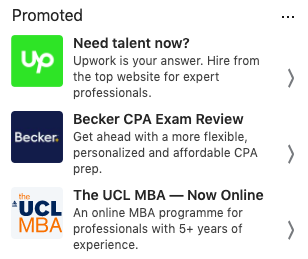
- Dynamic ads also appear to the right of the feed, but they are personalized by pulling the viewer’s name and profile pic right into the ad. This type of ad can be used to encourage the reader to follow your company page, promote downloadable content, or push a product, service, event, etc., like this one:
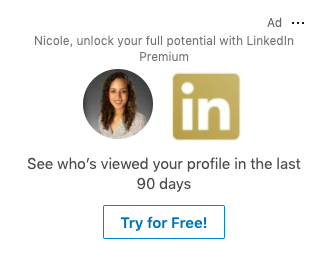
- Sponsored content takes the form of a native ad that appears within the feed (distinguished from non-ads by a “Promoted” label). These ads can incorporate single images, carousels, or video, and they show up on both desktop and mobile.
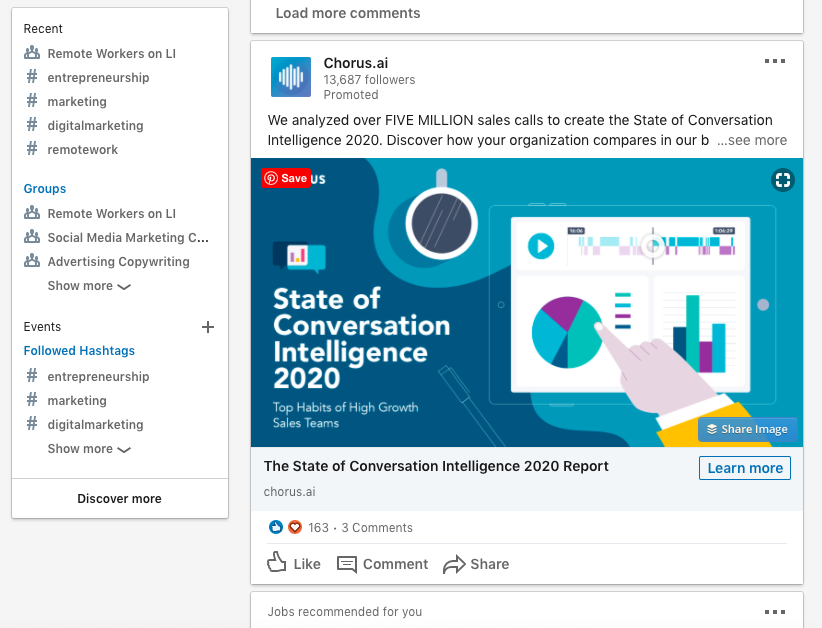
- Sponsored messages are native ads that are sent right to your audience’s LinkedIn inbox. You can send these ads in “message” or “conversation” format.
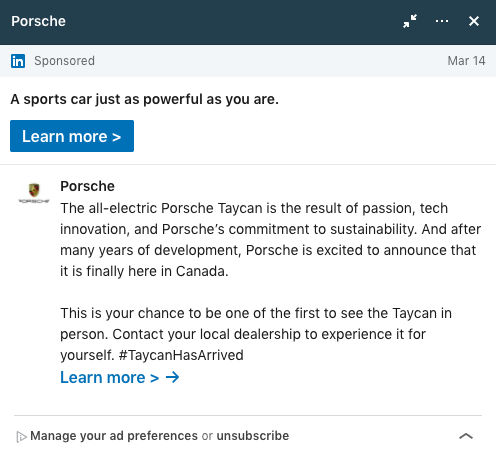
As you can see, these ad types are quite different. While companies will experience varying success rates with each format, there are some recommended use cases for each type of ad that can give you somewhere to start.
How To Use Analytics To Measure Your Efforts
It’s no good having a strategy for LinkedIn marketing, hitting the ground running, and then realizing you have no idea how you’re actually doing.
You need to measure your performance. But which analytics do you track?
Luckily, LinkedIn makes tracking all kinds of things easy with its native analytics dashboard, where you can review metrics pertaining to your published updates, your followers, and your page visitors.
Updates Page
The Updates page is where you can find out which posts are resonating with your audience.
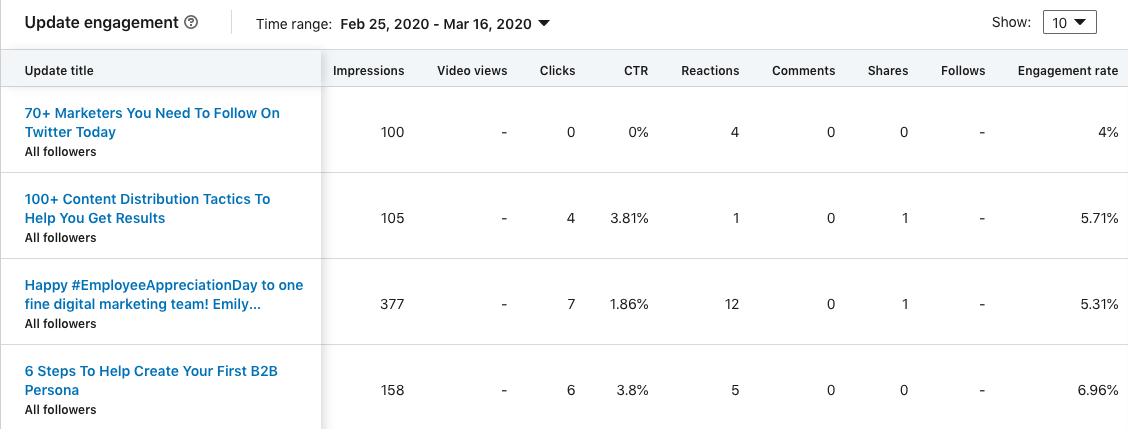
There are a few metrics here, so I’ll tell you the two most important ones to look at:
- CTR (click-through rate)
- Engagement rate
What makes these two metrics particularly important is that they provide a more balanced analysis of how each post is doing in relation to others.
For example, if you have five clicks on one post and 10 clicks on another, which post is doing better? You might say, “Well, the one with 10 clicks, of course,” but what if five people saw your first post and all five clicked through, but 50 saw your second post and only 10 clicked through? Your perspective changes a little bit, doesn’t it? That’s what CTR does for you. Why didn’t those other 40 people click through? You’d want to figure that out.
Similarly, 800 impressions sounds lovely in theory, but out of those impressions, who actually interacted with (liked, commented, shared, etc.) your content? That’s what the engagement rate tells you. These two metrics help you compare apples to apples.
Followers Page
You can also check on how you stack up against the competition. You can find these insights on the Followers page of your analytics.

Scroll to the bottom to find “Companies to track” to see how your metrics look compared to those of similar companies. (Keep in mind that these companies are determined by LinkedIn, and you can’t edit them yourself.)
Visitors Page
Finally, you can get an inside look at the people who aren’t followers but are viewing your business on the Visitors page. This page provides similar insights to those on the Followers page, but it also shows how much of your traffic is coming in on mobile vs. desktop.
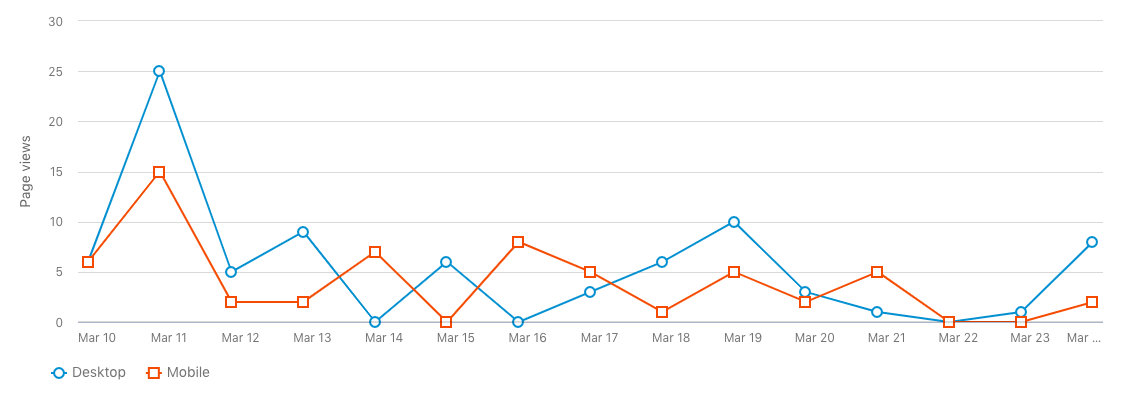
I will add that LinkedIn has an extensive conversion tracking dashboard where you can monitor how your ads are performing, so definitely dig into that as well!
Examples Of B2B Companies Killing It On LinkedIn
There are some brands that really know what they’re doing on LinkedIn — and as a result, their audiences are super engaged.
Check out a few of my favorites:
Xerox
You get a strong sense of community when you scroll Xerox’s feed, loaded with images of its employees — behind the scenes, on the job, and in the community. And Xerox makes great use of its own community (branded) hashtags.
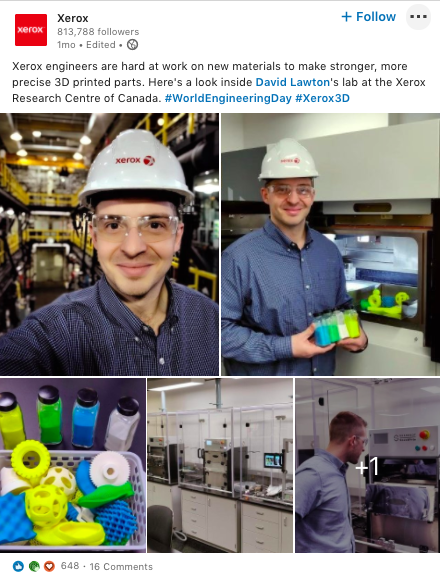
Adobe
Adobe is a big company with many business segments, and they all play a very different and active role on LinkedIn. Each affiliate page (aka showcase page) posts content catered to its distinct audience.
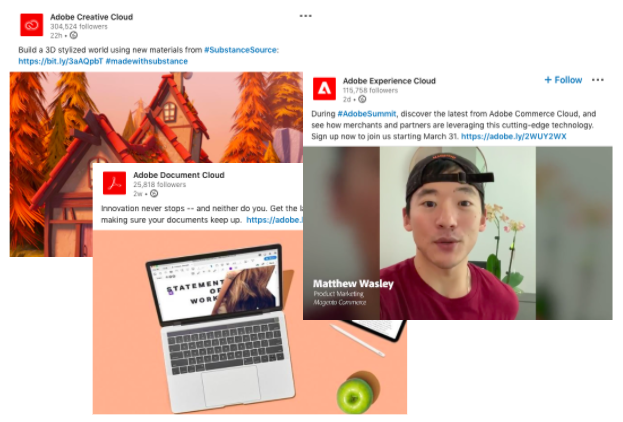
Dropbox
Dropbox incorporates a mix of media into its updates. The company’s use of custom videos and imagery makes its page look like an aesthetically pleasing Instagram feed.
All of the above companies are responsive to current events, post consistently, and remain true to their brand throughout.
Now, Over To You…
If you’re a B2B brand and you’re not using LinkedIn, now’s the time. If you are using LinkedIn but have failed to see the results you want, spice things up and try some different tactics.
The best way to learn LinkedIn marketing is to do — test things out, make mistakes along the way, and keep improving.
In fact, to start marketing on LinkedIn, follow these three quick steps (it’ll take you 15 minutes tops!):
- If you don’t have a company page, create one.
- Fill in all the requested fields on your company profile (there are nine).
- Share a link to your LinkedIn page in an email or a tweet, or link back to it on your website.
Congratulations! You’ve completed the first three steps toward creating a LinkedIn page that’ll attract potential customers to your brand. Now take this guide and get to work.
To help you, we’ve created a PDF version of this guide that you can download, save and reference at any time!
Get a PDF version of this guide
We’ll send you a downloadable PDF of this guide for you to check out later and share with your team.
By downloading this resource, you’ll also start receiving a few emails per week on B2B growth and content marketing.
While you’re at it—give Foundation a follow on LinkedIn!







